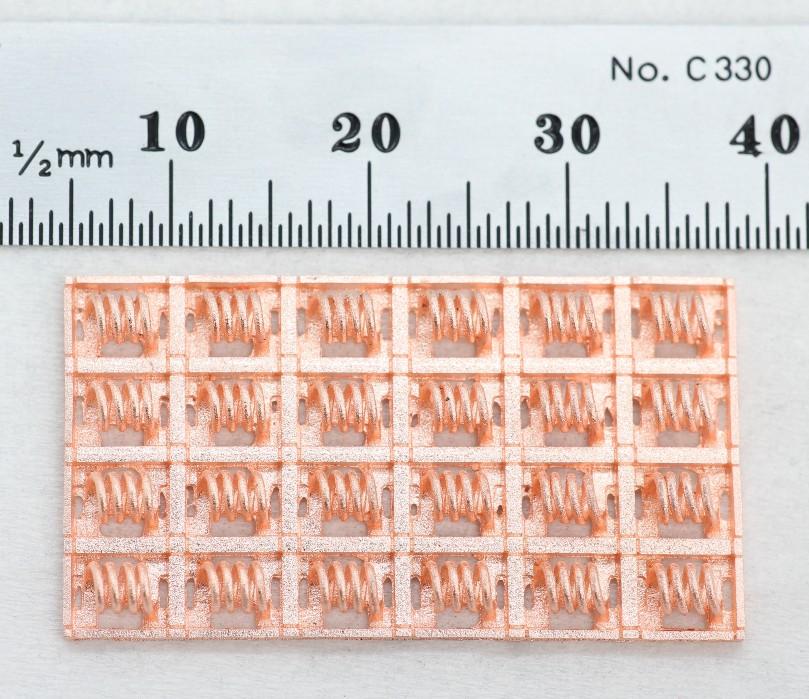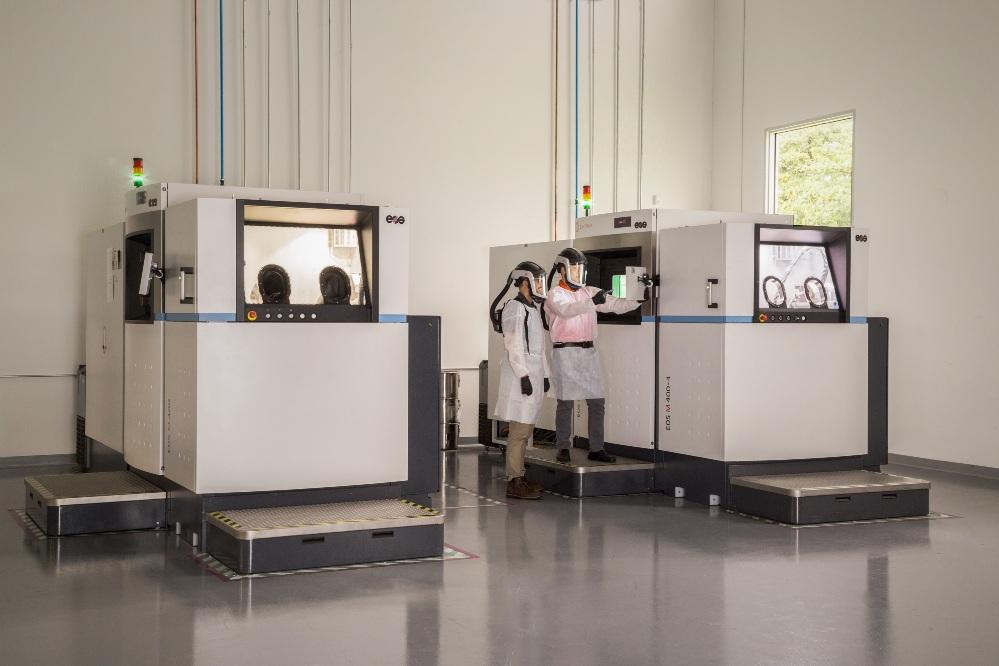- FMA
- The Fabricator
- FABTECH
- Canadian Metalworking
Our Publications
Categories
- Additive Manufacturing
- Aluminum Welding
- Arc Welding
- Assembly and Joining
- Automation and Robotics
- Bending and Forming
- Consumables
- Cutting and Weld Prep
- Electric Vehicles
- En Español
- Finishing
- Hydroforming
- Laser Cutting
- Laser Welding
- Machining
- Manufacturing Software
- Materials Handling
- Metals/Materials
- Oxyfuel Cutting
- Plasma Cutting
- Power Tools
- Punching and Other Holemaking
- Roll Forming
- Safety
- Sawing
- Shearing
- Shop Management
- Testing and Measuring
- Tube and Pipe Fabrication
- Tube and Pipe Production
- Waterjet Cutting
Industry Directory
Webcasts
Podcasts
FAB 40
Advertise
Subscribe
Account Login
Search
3D-printed copper parts help spacecraft chill out
Copper’s thermal properties make it critical to the manufacture of rocket propulsion systems
- By William Leventon
- September 18, 2021
- Article
- Additive Manufacturing

Sintavia has developed a proprietary 3D printing technology for GRCop-42, a copper alloy used by NASA and commercial suppliers of spacecraft components. Sintavia
The prospects of copper being used as an additive manufacturing material are looking up these days, thanks in no small part to the exploits of “Wild West space cowboys.”
That’s Pavlo Earle’s colorful way of describing the pioneers driving developments in the commercial spaceflight industry. Copper’s thermal properties make it a critical ingredient in rocket propulsion systems, noted Earle, vice president of engineering at Sintavia LLC, a Hollywood, Fla., firm that designs and 3D-prints components for space and defense systems.
Copper provides “very good heat transfer, so it’s good for cooling,” he said. “And rocket components need a lot of cooling.”
Sintavia recently announced development of a proprietary printing technology for GRCop-42, a copper alloy used by NASA and private spaceflight companies. The technology eliminates the need for hot isostatic pressing as a postprocessing step, reducing production time, costs, and complexity, according to the company.
Sintavia primarily uses direct metal laser sintering (DMLS), a powder-bed fusion technique, to print copper parts. The company produces rocket thrust chamber assemblies from copper for a number of customers. Most of the parts are large components installed in propulsion assemblies that can take days, or even weeks, to produce. Cooling features are integrated into the parts, which are difficult to manufacture due in part to their geometric complexity.
“Making these components conventionally would be very difficult and require a lot more time and cost,” Earle said, adding, “you can’t just machine a heat exchanger out of a block of material. You have to machine all the little parts and join them together.”
In addition to its thermal properties, copper offers good electrical conductivity.
“If you exclude precious metals, which are too costly for most applications, copper is the metal with the highest thermal and electrical conductivity,” said Hal Zarem, CEO of Holo Inc., a Newark, Calif., additive manufacturer of pure copper parts. “So virtually all applications for copper are thermal or electrical.”
Pure Copper Printing
Holo’s PureForm printing process, based on digital light processing technology, involves printing copper combined with a polymer binder and then sintering to remove the polymer. The process can produce pure copper parts with high thermal and electrical conductivity and fine features, according to Arian Aghababaie, Holo’s co-founder and president.
PureForm’s ability to produce fine features—combined with the inherent advantages of additive manufacturing, such as maximizing design freedom—allow the technology to print intricate copper structures that outperform copper parts made with traditional manufacturing processes, Aghababaie said. Today, these parts are used to cool high-power semiconductor devices and in radiofrequency (RF) systems utilized by a variety of industries.

Holo additively manufactured these 24 micro-inductor coils on one of its PureForm platforms. Twenty such arrays can be printed simultaneously. The coil strands have a diameter of 400 microns.Holo
According to Zarem, many devices contain large copper plates that, for the most part, don’t require a special manufacturing process but do include an “intricate portion” suitable for 3D printing. “Customers come to us to print smaller portions of a copper system, and then they weld, solder, or braze the 3D-printed part into a larger assembly,” he explained.
In other cases, like the production of RF micro-inductor coils, the whole part is printed. “But both cases require the fine features and design freedom that our technology offers,” he said.
Whatever technology is used to print copper, those undertaking the task need to remember that copper will oxidize fairly quickly if exposed to oxygen or other elements in the environment. To prevent oxidation from ruining copper powder, users must operate their systems in a pristine environment and take care when storing and transporting materials, Earle said.
Copper Contenders
While it’s possible to print copper parts with a number of additive technologies, the right choice will depend on the application.
Aghababaie, for example, sees fused filament fabrication (FFF) mainly as a prototyping technology—not a production tool. In addition, he said, FFF parts can experience delamination that adversely affects through-plane conductivity.
“There have been demonstrations of pure copper printing with these technologies, but not to the point where they can produce at production scale,” he said.
As for electron-beam melting and directed energy deposition (DED), Aghababaie described these as “generally pretty low-resolution technologies” that produce parts with high surface roughness that can render them useless in electrical applications. This means copper components made with these technologies will require a considerable amount of postprocessing to be transformed into functional parts.
DED also falls short compared to powder-bed fusion when it comes to producing fine features, Earle said. He noted, however, that DED can produce larger parts and requires less time to produce parts.
He also pointed out that copper’s reflectivity complicates printing with laser-based processes like DMLS. “If you’re trying to melt copper with a laser and it reflects off [the material] and doesn’t absorb that energy, that makes it very challenging,” he said.
DMLS success with copper depends on the particular process for dealing with reflectivity and the other difficulties the material presents. “We have developed proprietary parameters for our copper printing technology,” Earle said. “And we have achieved very good mechanical properties through a unique combination of handling, printing, and postprocessing steps.”
About the Author

William Leventon
(609) 926-6447
About the Publication
- Podcasting
- Podcast:
- The Fabricator Podcast
- Published:
- 04/16/2024
- Running Time:
- 63:29
In this episode of The Fabricator Podcast, Caleb Chamberlain, co-founder and CEO of OSH Cut, discusses his company’s...
- Trending Articles
- Industry Events
16th Annual Safety Conference
- April 30 - May 1, 2024
- Elgin,
Pipe and Tube Conference
- May 21 - 22, 2024
- Omaha, NE
World-Class Roll Forming Workshop
- June 5 - 6, 2024
- Louisville, KY
Advanced Laser Application Workshop
- June 25 - 27, 2024
- Novi, MI



























